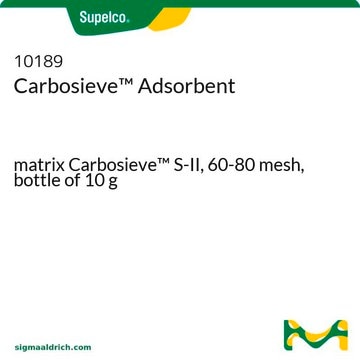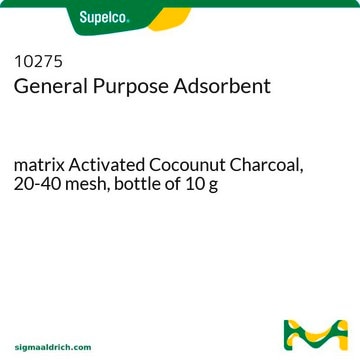11048-U
Carboxen® Carbon Adsorbent
matrix Carboxen® 569, 20-45 mesh, bottle of 500 g
Synonym(e):
carbon adsorbent, CMS, 60-80 mesh
About This Item
Empfohlene Produkte
product name
Carboxen® Adsorptionsmittel, matrix Carboxen® 569, 20-45 mesh, bottle of 500 g
Produktlinie
Carboxen®
Qualitätsniveau
Form
powder
Verpackung
bottle of 500 g
Methode(n)
LPLC: suitable
Oberflächenbereich
~485 m2/g
Matrix
Carboxen® 569
Aktive Matrixgruppe
carbon
Partikelgröße
20-45 mesh
Porengröße
~0.10 cm3/g macroporosity
~0.14 cm3/g mesoporosity
~0.20 cm3/g microporosity
~5-8 Å pore diameter
Dichte
~0.61 g/mL (free fall density)
Trenntechnik
reversed phase
Suchen Sie nach ähnlichen Produkten? Aufrufen Leitfaden zum Produktvergleich
Verwandte Kategorien
Allgemeine Beschreibung
Anwendung
Leistungsmerkmale und Vorteile
- Sphärisch
- Hart (Ball-Pan-Hardness >98 %)
- Stabil bis 400 °C
- Hohe Reinheit
- Einfaches Packing
- Stabil über den gesamten pH-Bereich
- Erzeugen keinen Gegendruck
- Hohe osmotische Schockstabilität
- Gestaffelte Porengröße (von Makro zu Meso zu Mikro)
Sonstige Hinweise
Rechtliche Hinweise
WGK
nwg
Flammpunkt (°F)
Not applicable
Flammpunkt (°C)
Not applicable
Persönliche Schutzausrüstung
Eyeshields, Gloves, type N95 (US)
Choose from one of the most recent versions:
Analysenzertifikate (COA)
Sorry, we don't have COAs for this product available online at this time.
If you need assistance, please contact Kundensupport
Besitzen Sie dieses Produkt bereits?
In der Dokumentenbibliothek finden Sie die Dokumentation zu den Produkten, die Sie kürzlich erworben haben.
Kunden haben sich ebenfalls angesehen
Artikel
Carbon Molecular sieves (CMS) are a versatile range of adsorbents that can be tailored for specific applications. Supelco® scientists have been synthesizing synthetic CMS carbons for several decades, starting from tailoring of the starting polymers/copolymers, to modifying the final properties of the subsequent CMS carbon.
Unser Team von Wissenschaftlern verfügt über Erfahrung in allen Forschungsbereichen einschließlich Life Science, Materialwissenschaften, chemischer Synthese, Chromatographie, Analytik und vielen mehr..
Setzen Sie sich mit dem technischen Dienst in Verbindung.


